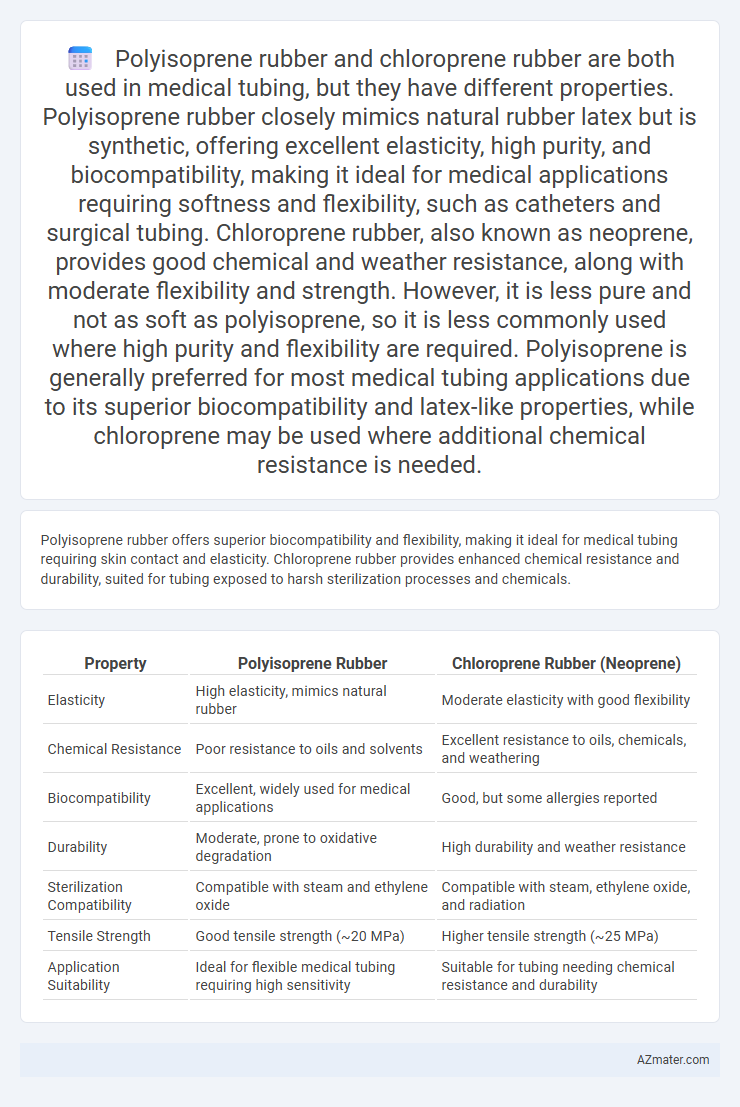Polyisoprene rubber offers superior biocompatibility and flexibility, making it ideal for medical tubing requiring skin contact and elasticity. Chloroprene rubber provides enhanced chemical resistance and durability, suited for tubing exposed to harsh sterilization processes and chemicals.
Table of Comparison
| Property | Polyisoprene Rubber | Chloroprene Rubber (Neoprene) |
|---|---|---|
| Elasticity | High elasticity, mimics natural rubber | Moderate elasticity with good flexibility |
| Chemical Resistance | Poor resistance to oils and solvents | Excellent resistance to oils, chemicals, and weathering |
| Biocompatibility | Excellent, widely used for medical applications | Good, but some allergies reported |
| Durability | Moderate, prone to oxidative degradation | High durability and weather resistance |
| Sterilization Compatibility | Compatible with steam and ethylene oxide | Compatible with steam, ethylene oxide, and radiation |
| Tensile Strength | Good tensile strength (~20 MPa) | Higher tensile strength (~25 MPa) |
| Application Suitability | Ideal for flexible medical tubing requiring high sensitivity | Suitable for tubing needing chemical resistance and durability |
Introduction to Medical Tubing Materials
Polyisoprene rubber offers excellent biocompatibility, flexibility, and natural latex-like properties, making it ideal for sensitive medical tubing applications such as catheters and drainage tubes. Chloroprene rubber, also known as neoprene, provides superior chemical resistance, durability, and resistance to oxidation and ozone, enhancing the longevity and reliability of medical tubing exposed to harsh environments or disinfectants. Both materials are critical in medical tubing, with polyisoprene preferred for patient comfort and chloroprene for mechanical strength and chemical stability.
Overview of Polyisoprene Rubber
Polyisoprene rubber, a synthetic version of natural rubber, offers excellent elasticity, biocompatibility, and resistance to kinking, making it highly suitable for medical tubing applications. It demonstrates superior tensile strength and low protein binding, which helps minimize allergic reactions and enhances patient safety during medical procedures. Compared to chloroprene rubber, polyisoprene provides improved softness and flexibility, ensuring greater comfort and functionality in sensitive healthcare environments.
Overview of Chloroprene Rubber
Chloroprene rubber, also known as neoprene, offers excellent chemical stability, oil resistance, and durability, making it highly suitable for medical tubing applications requiring long-term reliability. Its inherent resistance to oxidation, ozone, and weathering provides enhanced performance over polyisoprene rubber, which is more prone to degradation. Chloroprene rubber's balanced flexibility and strength ensure consistent elasticity and resilience, essential for maintaining sterile environments and patient safety in medical devices.
Physical and Mechanical Properties Comparison
Polyisoprene rubber exhibits excellent elasticity, tensile strength of approximately 20-25 MPa, and superior tear resistance, making it ideal for flexible and durable medical tubing. Chloroprene rubber offers good chemical resistance, moderate tensile strength around 15-20 MPa, and enhanced resistance to abrasion and weathering, suitable for tubing exposed to harsher environments. The choice between polyisoprene and chloroprene depends on the need for flexibility versus chemical durability in medical applications.
Biocompatibility and Safety Considerations
Polyisoprene rubber offers excellent biocompatibility with low allergenic potential, making it ideal for medical tubing applications requiring hypoallergenic materials. Chloroprene rubber provides strong chemical resistance and durability but may pose higher risks of adverse reactions due to residual chlorinated compounds. Safety considerations prioritize polyisoprene for its proven non-toxicity and reduced patient sensitization in critical medical device usage.
Chemical Resistance and Sterilization Suitability
Polyisoprene rubber offers excellent biocompatibility and flexibility but has limited chemical resistance, especially against oils and solvents, which can restrict its use in medical tubing exposed to harsh chemicals. Chloroprene rubber demonstrates superior chemical resistance, including against acids and alkalis, making it more suitable for medical tubing requiring durability in diverse sterilization environments such as autoclaving and chemical sterilants. Its enhanced resistance to oxidative and ozone degradation ensures Chloroprene rubber maintains integrity and performance during repeated sterilization cycles, unlike Polyisoprene rubber, which may degrade faster under such conditions.
Flexibility and Durability in Medical Applications
Polyisoprene rubber offers superior flexibility and close-to-natural latex elasticity, making it ideal for sensitive medical tubing requiring high compliance and patient comfort. Chloroprene rubber exhibits excellent durability, chemical resistance, and aging stability, ensuring long-lasting performance in medical environments with frequent sterilization and exposure to bodily fluids. For medical tubing applications, polyisoprene prioritizes flexibility while chloroprene emphasizes durability under harsh conditions.
Cost and Availability Analysis
Polyisoprene rubber offers superior biocompatibility and elasticity for medical tubing but tends to be more expensive due to its limited production scale compared to chloroprene rubber. Chloroprene rubber is widely available and cost-effective, benefiting from established manufacturing infrastructure and higher global supply. Cost analysis reveals chloroprene rubber as the preferred choice for budget-sensitive applications, while polyisoprene is favored when performance justifies the increased expense.
Typical Medical Uses: Polyisoprene vs Chloroprene
Polyisoprene rubber is commonly used in medical tubing for applications requiring high elasticity, biocompatibility, and low allergenic potential, such as catheters and blood pressure cuffs. Chloroprene rubber, known for its superior chemical resistance and durability, is preferred in tubing exposed to harsh chemicals and sterilization processes, including wound drainage and suction devices. Both materials offer flexibility and strength, but polyisoprene is favored for sensitivity-sensitive applications while chloroprene suits environments demanding higher resistance.
Choosing the Right Rubber for Medical Tubing
Polyisoprene rubber offers excellent elasticity and biocompatibility, making it ideal for medical tubing that requires flexibility and patient comfort. Chloroprene rubber provides superior chemical resistance and durability, suitable for tubing exposed to harsh disinfectants and sterilization processes. Selecting the right rubber depends on the specific medical application, balancing the need for softness and stretchability with resistance to chemicals and environmental factors.

Infographic: Polyisoprene rubber vs Chloroprene rubber for Medical tubing
 azmater.com
azmater.com